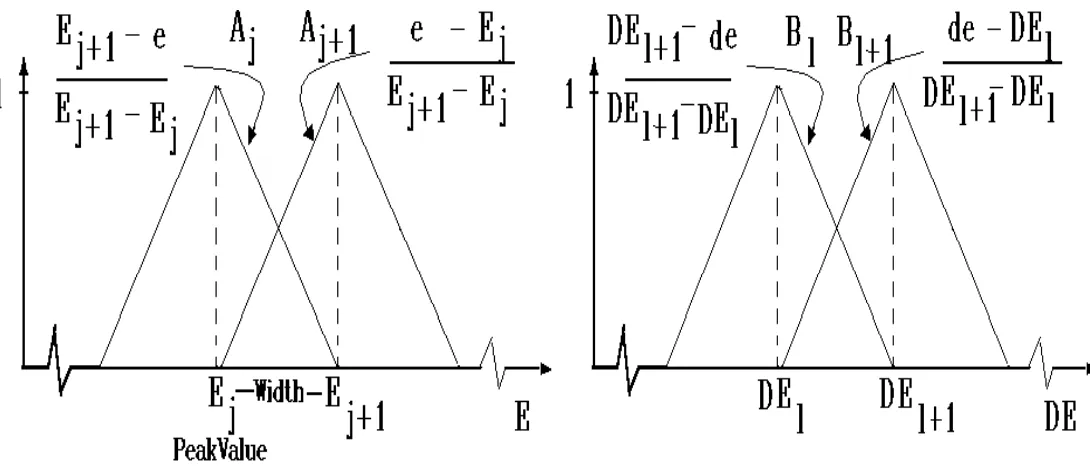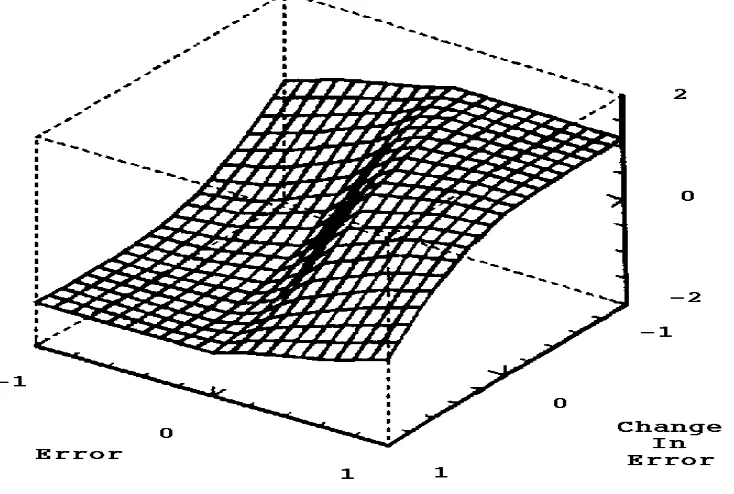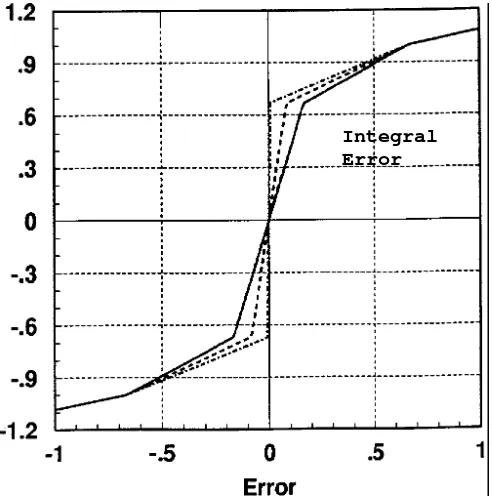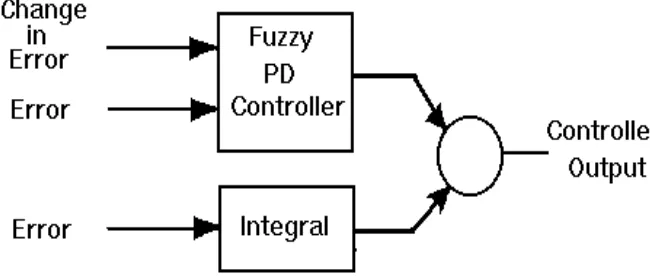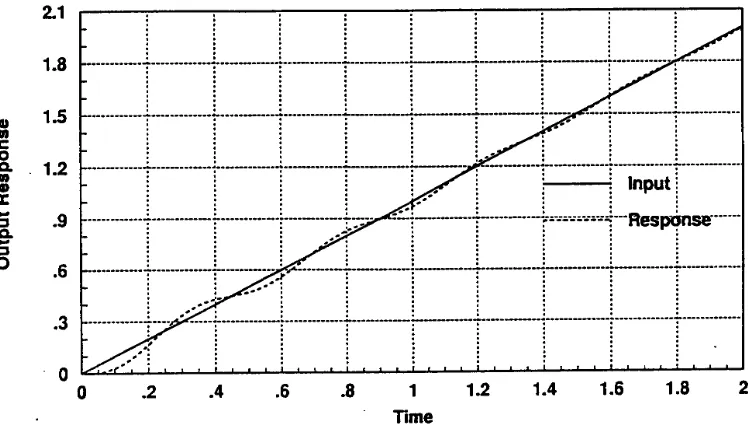HYBRID FUZZY LOGIC PID CONTROLLER
Thomas Brehm and Kuldip S. Rattan
Department of Electrical Engineering Wright State University
Dayton, OH 45435
Abstract
This paper investigates two fuzzy logic PID controllers that use simplified design schemes. Fuzzy logic PD and PI controllers are effective for many control problems but lack the advantages of the fuzzy PID controller. Design methodologies are in their infancy and still somewhat intuitive. Fuzzy controllers use a rule base to describe relationships between the input variables. Implementation of a detailed rule base increases in complexity as the number of input variables grow and the ranges of operation for the variables become more defined. We propose a hybrid fuzzy PID controller which takes advantage of the properties of the fuzzy PI and PD controllers and a second method which adds the fuzzy PD control action to the integral control action. The effectiveness of the two PID fuzzy controller implementations are illustrated with examples.
1 Introduction
Fuzzy controllers demonstrate excellent performance in numerous applica-tions such as industrial processes [8] and flexible arm control [5]. Mamdami's [3] work introduced this control technology that Zadeh pioneered with his work in fuzzy sets [9]. Unlike "two valued" logic, fuzzy set theory allows the degree of truth for a variable to exist somewhere in the range [0,1]. For example, if pressure is a linguistic variable that describes an input, then the terms low, medium, high and dangerous describe the fuzzy set for the pressure variable. If the universe of discourse for pressure is [0, 100], then low could be defined as "close to 10", "medium" is "around 40", and so on. For control applications, linguistic variables describe the control inputs for dynamic plants and rules define the relationships between the in-puts. Thus, precise knowledge of a plant's transfer function is not necessary for design and implementation of the controller. The thrust of earlier efforts involved replacing humans in the control loop by describing the operators' actions in terms of linguistic rules.
across each range determines the membership of the variable's current value to the fuzzy subset. Linguistic rules express the relationship between input variables. Table I is an example of a matrix of rules to cover all possible combinations of fuzzy subsets for two input variables. In this case, each variable has seven subsets that gives a total of 49 rules. Defuzzification to determine the "crisp output", resolves the applicable rules into a single output value.
Recent research into fuzzy control has applied classical techniques to stability analysis [1] and design [6,10]. The operation of a fuzzy controller behaves similar to a classical PD or PI controller [1,6]. For a classical PD controller, the position and derivative gains remain constant for all values of input. However, for a fuzzy controller, the gains depend on the range where the control variables exist at any instant. The piecewise linearity of the fuzzy controller provides better system response than a classical controller [2,6,7]. Also, since the operating point of the fuzzy controller is not fixed, it provides improved robustness to changes in the system parameters as compared to a classical controller.
Design concepts for fuzzy controllers involve manipulating the fuzzy subsets and rules to obtain the desired effective controller gain. Section 2 discusses design techniques for PI and PD like fuzzy controllers as well as the drawbacks of each. As the number of control variables increase, implementation of the design becomes more complicated. Two hybrid PID fuzzy controllers that involve a simplified design and implementation are investigated in Section 3. Simulations to demonstrate the effectiveness of the PID fuzzy controllers are given in Section 4 and some conclusions are drawn in Section 5.
2 Fuzzy Logic Controllers
Expression of the fuzzy control action in a closed form [1,6] provides insight into how the fuzzy subsets and output values affect the controller response. The fuzzification of a control variable consists of applying a membership function to each of the fuzzy subsets for that
Table I: PD Control Rule Matrix
Change In Error
Error
control variable. For our design process, we choose the triangular function because of its simplicity and effectiveness. The peak value of a membership function is the point where the output is unity and the width is the distance to zero membership as shown in figure 1. If the width extends to the adjacent subset's peak value and vice versa, the sum of the applied memberships over that interval will be one. Therefore, if all subsets are implemented with the widths extended to adjacent peaks, the total membership over the universe of discourse for that control variable will always be equal to one. Figure 1 shows that if the value of E is between Ej and Ej+1, then these two fuzzy subsets Aj and Aj+1 are active and the membership for Aj is EE Ee
j j j
+ +
− − 1
1 and Aj+1 is
e E E E
j j j
− −+
+
1
1 . These memberships sum to one as expected. Figure 1 also shows
the similar case for the second control variable.
Two control variables of a PD like controller have four "active" subsets that give four applicable rules expressed as:
Rjl: if e(t) is Aj and de(t) is Bl then u(t) is Cil Rj+1l: if e(t) is Aj+1 and de(t) is Bl then u(t) is Cj+1l Rjl+1: if e(t) is Aj and de(t) is Bl+1 then u(t) is Cjl+1 Rj+1l+1: if e(t) is Aj+1 and de(t) is Bl+1 then u(t) is Cj+1l+1
where e(t), de(t), u(t) are the error, change of error and output respectively. The crisp output control action is determined by applying the control rules to a variation of the centroid of area (COA)
defuzzification scheme given by
u t
i iU
i i i( )
= ∑
∑
µ
µ
(1)where µi is the product rule; [membership of e in Aj]x[membership of de in Bl] and Ui is the output value Cjl. The product rule is necessary for obtaining a closed form of the expression for u(t) [1,4,6] and equation (1) expands to
) )( ( ] [ ] [ ) )( ( ] [ ] [ ) )( ( ] [ ] [ ) )( ( ] [ ] [ 1 1 , 1 1 1 , 1 1 , , 1 1 1 1 , 1 1 , 1 1 , , 1 1 1 , , 1 , 1 , 1 1 1 , 1 1 1 , 1 1 ,
)
*
(
)
(
l l j j l j l l j l j l j l l j l J l l j j l j l j l j l j l l j j l l j l j j l j l j j l l j j l j j l l j l j l DE DE E E U DE U DE E U DE U DE E DE DE E E U U U U DE DE E E U U E U U E DE DE E E U U DE U U DEde
e
de
e
t
u
− − − + − − − − + − − − − + − − − − + − + + + + + + + + + + + + + + + + + + + + + + + + + + + + ++
+
+
=
(2)The four terms of equation (2) demonstrates how the variation of the control gains depend on the design of the fuzzification process and rule base. The first two terms are the linear portion of the controller. The error and change of error are multiplied by gains that are set according to the distance between adjacent peak values of the fuzzy subsets (i.e. Ej and Ej+1), and the difference between the output values (i.e. Uj,l and Uj+1,l) for the rules of the applied fuzzy subsets. Therefore, the narrower the widths of the fuzzy subsets and greater the difference between output values, the higher the effective gain. Also, if the peak values and/or fuzzy outputs between adjacent rules do not increase at exact intervals, the control action will vary in gain over the universe of discourse of the control variables. The third term is a product of the input control variables and a factor that is also based on the fuzzy subsets and output values. Finally, the fourth term is constant but depends on the fuzzy subset placement. If the third and fourth terms are ignored, the resultant expression indicates that a fuzzy controller behaves similar to a classical PD controller.
2.1 Design Concepts
is five and the universe of discourse will be between negative five and positive five. Obviously, a change in the scale factor affects all fuzzy rules. Modification of a single peak value only affects the rules that involve that particular fuzzy subset. Since the scale factors affect the whole rule base, they should be determined first. Adjustments to individual peak values are done to customize the con-troller response.
The first step for PD controller design is to assume that the universe of discourse for each control variable is [-1,1] and that the controller output is modeled as e·kp+∆e·kd = kp(e+∆e·kd/kp). The values for kp and kd are selected by using any typical classical controller design technique. The term kd/kp is the scale factor for the change in error term. The scale factor modification can be accomplished by multiplying the change in error input by kd/kp or multiplying each peak value of the change in error fuzzy subsets by kp/kd. The error term is input directly into the fuzzy logic controller. The output of the controller is then multiplied by the gain kp which is the scale factor for the control action output. The design steps for a fuzzy PI like controller are similar, but with ki∫e+e·kp = kp(e+ki/kp∫e).
The second step of the design process is to adjust the peak values of individual fuzzy subsets. The desired action of a PD type fuzzy controller initially has low gain of about one and an increase in the gain as the output reaches desired point. This is demonstrated in equation (2) which shows that the widths (or distance between peak values) of the subsets should decrease and the around zero subset (ZO) should be the narrowest [6]. For a fuzzy controller, the narrower the subset, the quicker the control action. In the previous step ist was assumed that the gain was constant at one. However, the maximum gain of the fuzzy controller has to ensure that the system is still stable.
The response of a PD controller is basically a control surface as illustrated in figure 2. Modification of the scale factors from the first step either expands or contracts the control surface along the dimension of the modified variable. The illustrated control surface has narrower subsets as the control variables approach ZO and increased difference in output values at the maximum subsets. A change in any peak value changes the effective gain in the localized area of the subset. Figure 2 also shows that the control surface is relatively smooth as the gain continuously increases toward the ZO region. The smoother the control surface, the smoother the response, Therefore, modification of the subsets to change the regional gain should keep the control surface smooth.
2.2 PD and PI Controller Limitations
Some of the limitations of classical PD and PI controllers carry over to their fuzzy counterparts. Like the classical PD controller, the fuzzy counterpart can not eliminate steady-state error. The fuzzy control action drives the plant to the zero subset for both the error and change in error (the center rule of the rule matrix). However, since the zero subset is defined as a range, it is possible to have a small error when the controller action is zero. In order to reduce the error, ZO for the error term can be made smaller so that there is contribution from the control action of adjacent rules of the matrix. Narrowing the ZO range corresponds to increasing the gain of the control surface at the center. Figure 3 shows that if the change in error is zero, and the ZO for the error term decreases to a width of zero, the control action becomes discontinuous. A discontinuous control action causes the plant response to oscillate.
Integral Error
The PI fuzzy controller has a slower response due to the integral error control variable. Intuitively, the controller response is a path through the matrix of control rules. Movement from the currently applied rule to the next rule is dependent on the current and next subset of each control variable. Movement from subset to subset based on the integral error control variable is slow because the integral error variable changes slowly, thus slowing down the fuzzy controller response.
3 Reduced Rule PID Controller
The number of rules to cover all possible input variations for a Fuzzy PD controller is simply the number of subsets for the error multiplied by the number of subsets for the change in error. The rule matrix expressed in Table I has seven subsets for error and seven subsets for change in error which gives 49 rules. Similarly, the PI control rule matrix has 49 rules. The addition of another control variable sig-nificantly increases the number of rules. For example, if the integral error control variable with seven subsets is added to the PD controller, there would be 343 control rules. Design of such a large rule base would be a tedious task.
As pointed out, the plant must be capable of being compensated by a PI controller for the hybrid controller method to work. In order to lift this restriction, a second approach as illustrated in figure 5 was implemented. The control action is the sum of a PD controller output and the integral of the error term scaled by a gain. As before, the PD controller provides the "coarse" control actions but is unable to eliminate the steady-state error. The integrator provides the additional signal to correct for error. The first step in design is to build the PD controller with the desired amount of rise time and the least amount of error. The integral gain determines how rapidly the steady-state error reduces.
4 Simulation Results
The control scheme including the fuzzy controller was implemented on the System_Build module of Matrixx. For the fuzzy controller, each control variable has been divided into seven ranges which gives a vector of length seven as the fuzzification output. An error block produces the
Figure 4. Hybrid PID Fuzzy Logic Controller
error membership values over the seven subsets and a change of error block outputs the change in error membership values. For the PD controller, defuzzification is accomplished by matrix multiplying the error membership vector by the rule gain table. The inner product between the resultant vector and the change of error block give the crisp output. The PI controller is implemented in a similar manner.
The hybrid fuzzy PID controller was used to control the servo motor with the transfer function G s( )= s s(+1. )
3 6 . The PD controller was designed to
have a ramp error of 2 percent and ξ = 1 which gives kp=72 and kd=13.34. The peak and output values are
E1 = -4/3
DE1 = -1
NB = -7/6
E2 = -2/3
DE2 = -2/3
NM = -1
E3 = 1/6
DE3 = -1/3
NS = -2/3
E4 = 0
DE4 = 0
ZO = 0
E5 = 1/6
DE5 = 1/3
PS = 2/3
E6 = 2/3
DE6 = 2/3
PM = 1
E7 = 4/3
DE7 = 1
PB = 7/6
These values give a gain of about 1 at the larger peak values and a gain of about 8 around the ZO subset.
The PI portion was designed with ki/kp to be .1 and kp to be 100; and the peak values and output scalars were the same as the PD portion. Figure 6 shows that after a slight overshoot, the ramp response settles to the desired input.
The fuzzy PD plus integral controller was used to control single link flexible arm with the transfer function G s( ) s .
.
= 43 75+ 43 75
2 . The type of the
system is zero which has a steady-state error for a step input. The PD portion design gives a step error of 2 percent and ξ = 1; kp=49 and kd=2.13. The peak and output values were the same as the PD controller from the hybrid method. The integral value that gave the best response was 30. The step response is shown in figure 7 The PD portion provides a critically damped response at first and the integral portions provides minimal action. At steady-state, the integral term adds the necessary action to eliminate the error and the PD portion provides minimal action.
5 Conclusions
of switching between the control actions. The second fuzzy PID control scheme used only the PD portion with an integral term added to eliminate steady-state error. Results from simulations of both control schemes demonstrate the effectiveness of the PID controllers.
References
1. Gholamresa Langari, A Framework for Analysis and Synthesis of Fuzzy Linguistic Control Systems, Ph.D. Thesis, University of California at Berkeley, December 1990.
2. Y. Li and C Lau, "Development of Fuzzy Algorithms for Servo Systems,"
IEEE Control Systems Magizine, pp 65-71, April, 1989.
3. E.H. Mamdani, "Application of Fuzzy Algorithms for Control of Simple Dynamic Plant," Proc. IEE 121 Vol. 12 pp. 1585-1588, 1974.
4. M. Mizumoto, "Realization of PID Controls By Fuzzy Control Methods," IEEE 1992.
5. Kuldip S. Rattan, B.Chiu, V Feliu and H.B. Brown Jr., "Rule Based Fuzzy Control of a Single-Link Flexible Manipulator in the Presence of Joint Friction and Load Changes," American Control Conference, Pittsburgh, PA, June 1989.
6. D. Sabharwal and K. Rattan, Design of a Rule Based Fuzzy Controller for the Pitch Axis of an Unmanned Research Vehicle," NAECON Proceedings, Dayton, 1992.
7. D. Sabharwal and K. Rattan, Design of a Rule Based Fuzzy Controller for the Pitch Axis of an Unmanned Research Vehicle," NAECON Proceedings, Dayton, 1991.
8. M. Sugeno, Industrial Applications of Fuzzy Control, North-Holland, 1985.
9. L. A. Zadeh, "Outline of a New Approach to the Analysis of Complex Systems and Decision Processes," IEEE Trans. Systems, Man Cybernetics, Vol 3, pp. 28-44, 1973.
